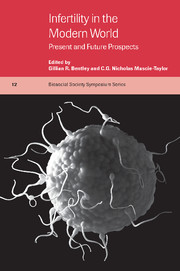Book contents
- Frontmatter
- Contents
- List of contributors
- 1 Introduction
- Part I Biomedical perspectives on fertility
- Part II Environmental influences on fertility
- 4 Environmental pollutants and fertility
- 5 From STD epidemics to AIDS: a socio-demographic and epidemiological perspective on sub-Saharan Africa
- Part III Social perspectives on infertility
- Index
5 - From STD epidemics to AIDS: a socio-demographic and epidemiological perspective on sub-Saharan Africa
Published online by Cambridge University Press: 13 January 2010
- Frontmatter
- Contents
- List of contributors
- 1 Introduction
- Part I Biomedical perspectives on fertility
- Part II Environmental influences on fertility
- 4 Environmental pollutants and fertility
- 5 From STD epidemics to AIDS: a socio-demographic and epidemiological perspective on sub-Saharan Africa
- Part III Social perspectives on infertility
- Index
Summary
Abstract
The formation of a global economy and society has been accompanied in developing regions of the world by an upswing in sexually transmitted diseases (STDs). This has resulted from changing patterns of living and movement and changes in sexual relations. This chapter examines why and how these changes occurred and their impact on fertility. The focus will be on sub-Saharan Africa but Asia, the Pacific and Latin America are more briefly considered. The chapter then examines the emerging evidence that human immunodeficiency virus (HIV) and acquired immune deficiency syndrome (AIDS) have both a biological and a social impact on fertility. Some attention is given to the older STDs as cofactors of AIDS and the evidence that the AIDS epidemic will lead to successful campaigns against these STDs in an effort to control HIV/AIDS. The role of cultural, social and behavioural factors is stressed.
Introduction
Childlessness or primary sterility is still a distressing condition for nearly all married women in most of the Third World. It can endanger marriage. The reaction of the childless woman's husband, and that of his relatives and the community, can make her a second class citizen and render her life a misery. Therefore, the level of childlessness among ever-married women who have completed their reproductive span can in most developing countries be equated with the true level of biological sterility within the marriage. It cannot be assumed to be a measure of the level of sterility of the wife, for, if she has confined her sexual activity to a single husband, as is commonly the case in much of Asia, it may be the latter who is sterile.
- Type
- Chapter
- Information
- Infertility in the Modern WorldPresent and Future Prospects, pp. 153 - 186Publisher: Cambridge University PressPrint publication year: 2000
- 1
- Cited by

